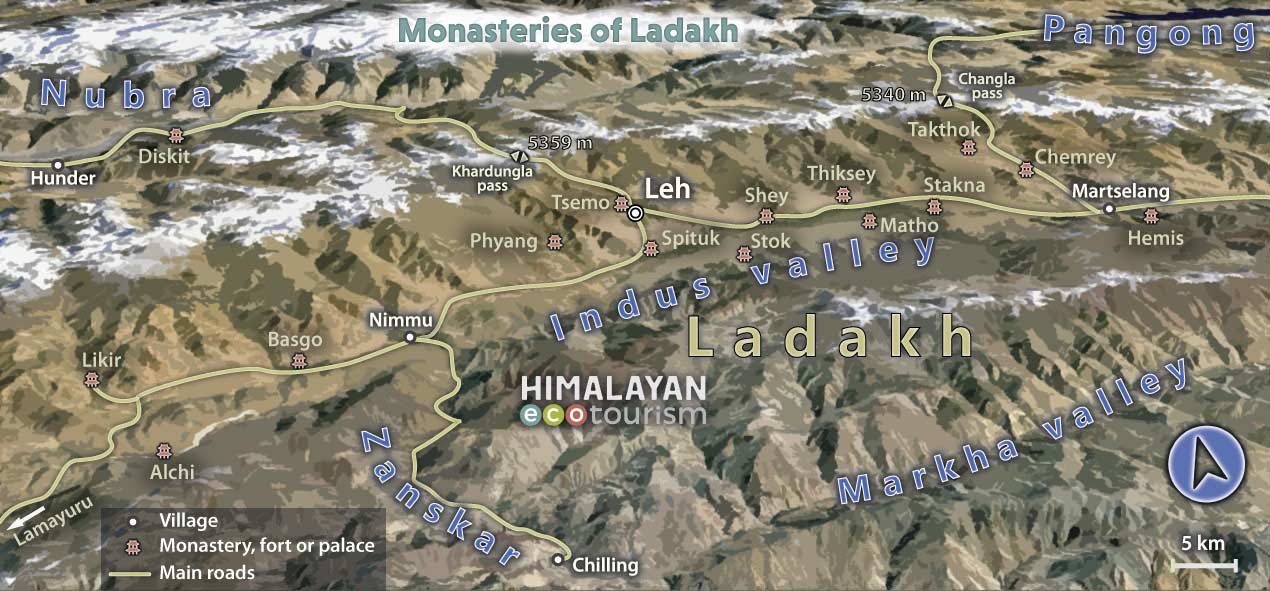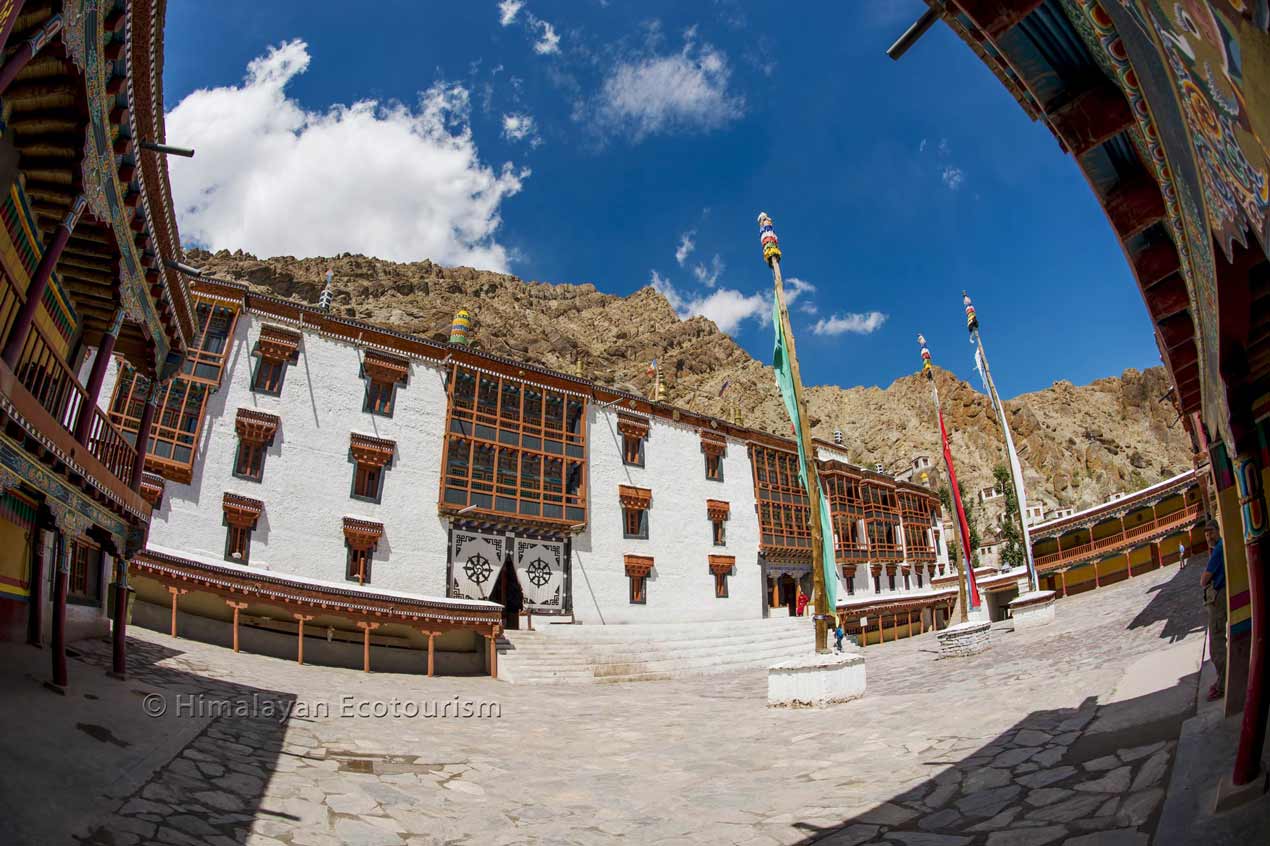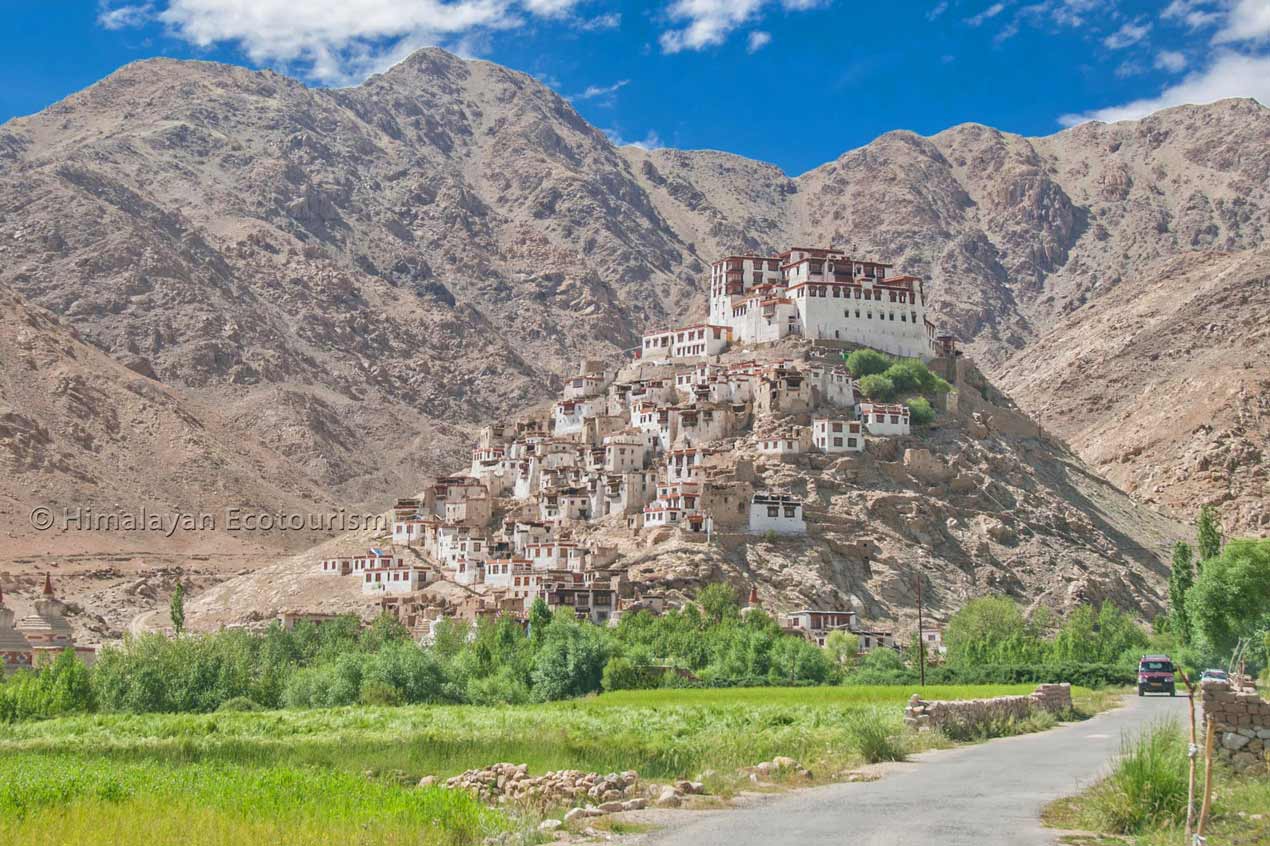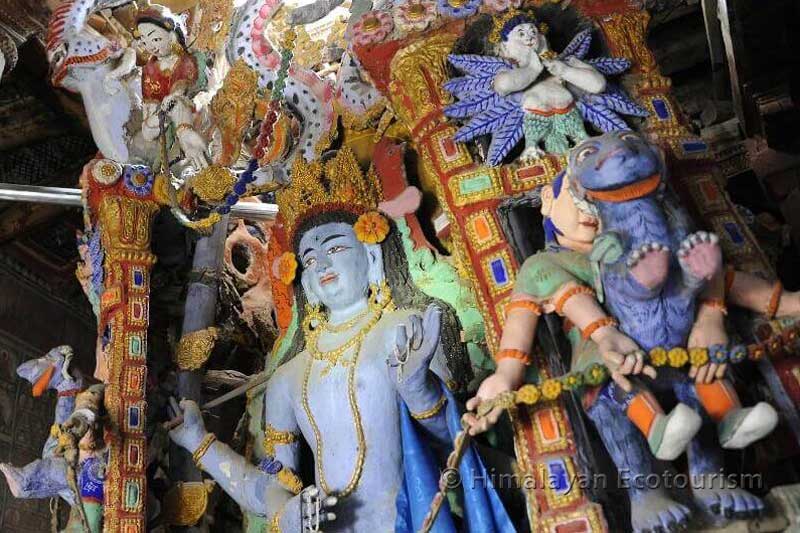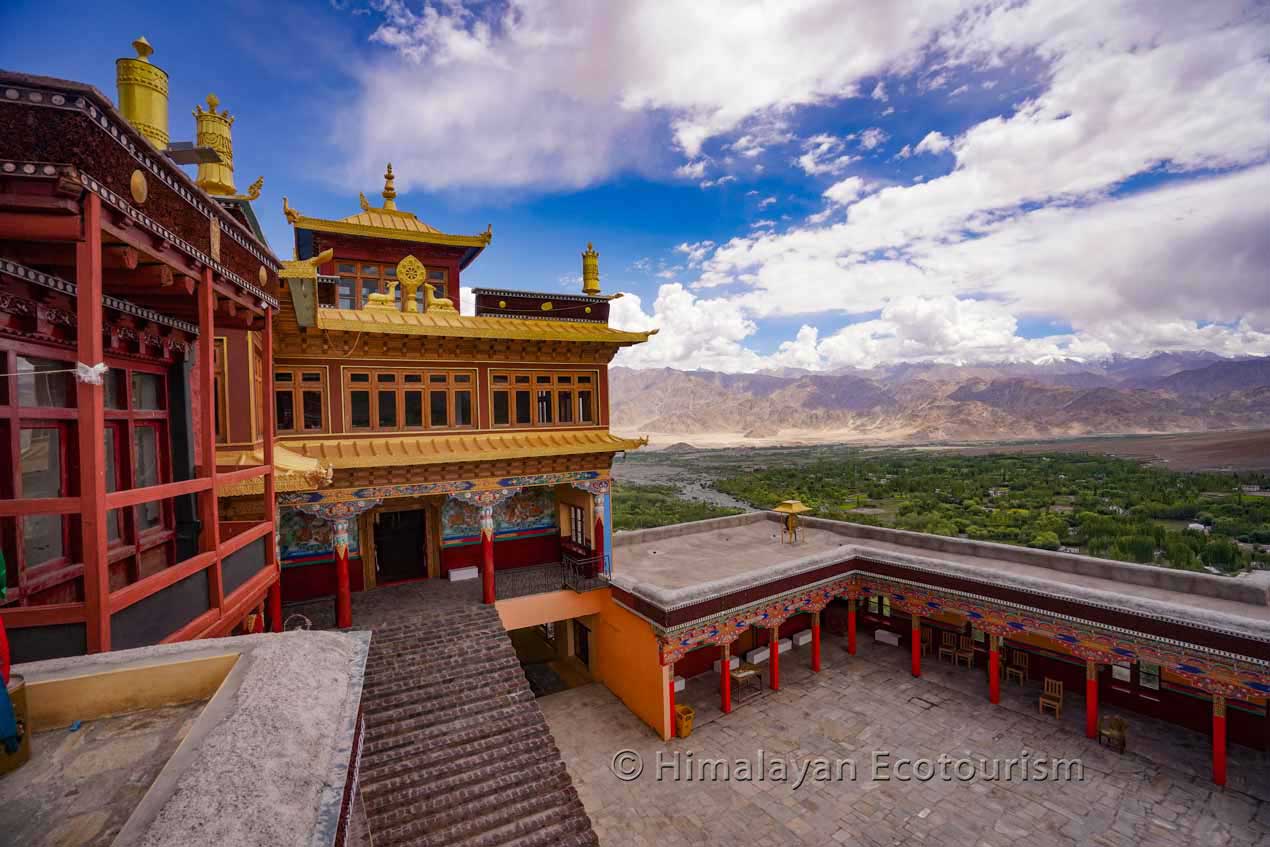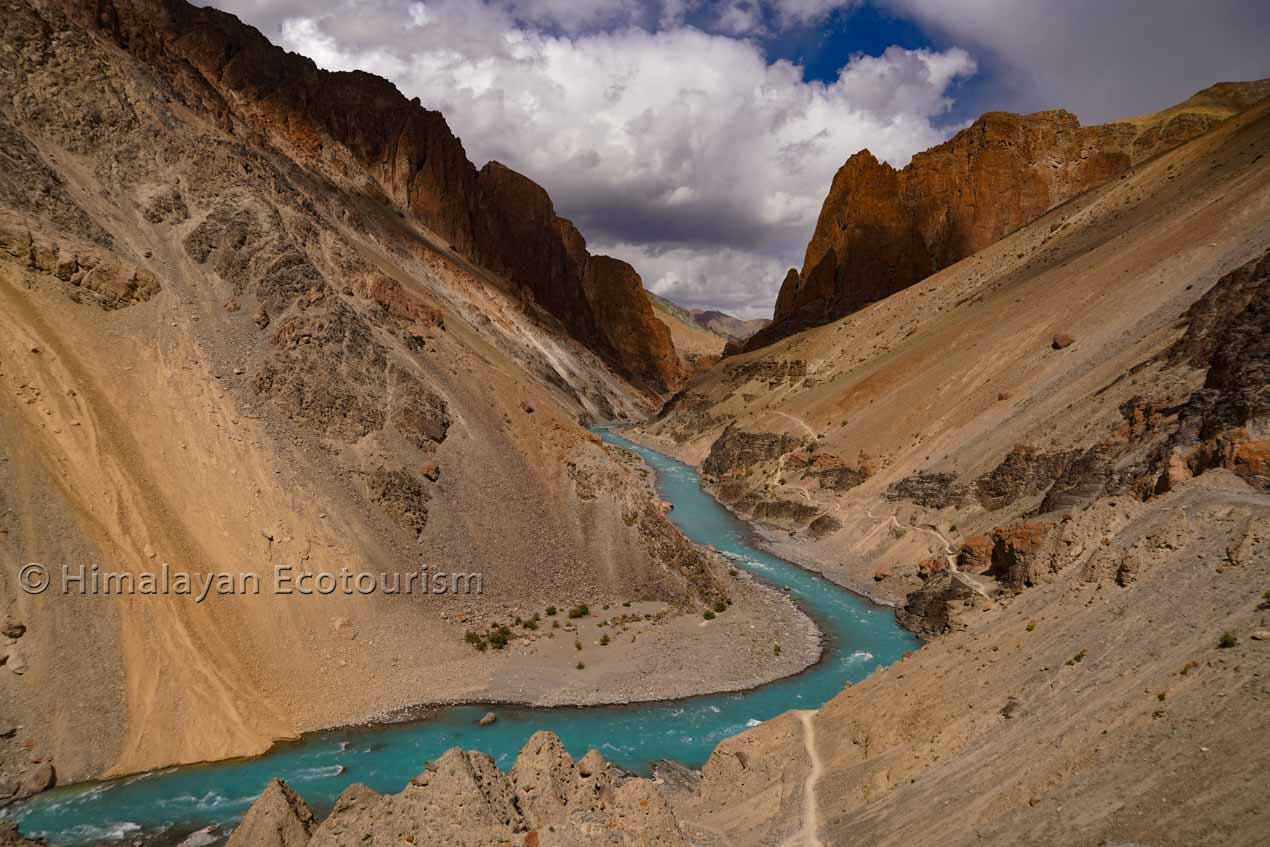Monasteries of Ladakh

Discover the Monasteries in Leh Ladakh
Think Leh Ladakh and you will conjure images of austere landscapes and colourful prayer flags signalling the practice of Buddhism and spirituality in the region. Ladakh, which was once ruled by Tibetan rulers and is in geographical proximity to Tibet, still retains Tibetan culture, among which are Tibetan food, Tibetan architecture, and Tibetan Buddhist monasteries. These monasteries are known for their mystical beauty and their history as some of them are centuries old.
Apart from their religious significance and the spiritual experience they offer, the monasteries of Ladakh also offer visitors a chance to interact with an old world through statues (some are several metres high!), artefacts, manuscripts, and thangkas that are present in the monasteries. You can also learn what monks do in a monastery such as witnessing their religious study, the sacred chanting in Tibetan and Sanskrit in the assembly halls of monasteries, and the local and state-wide festivals known for their masked dances and music.
There are many monasteries, or gompas, to explore while in Ladakh. These monasteries, built in traditional Tibetan architectural style, are generally complexes that comprise temples, assembly halls, courtyards, stupas, libraries, and the living quarters of monks.
The monasteries in Leh are usually a few kilometers outside the town. Leh serves as a gateway to these monasteries. Some monasteries are further off. All our tours include visits to some of Ladakh monasteries. We also have a Spiritual Tour of Ladakh, which specifically explores this facet of Ladakh with visits to monasteries as well as sessions with traditional healers such as shamans and amchi.
If you are well versed with the Tibetan Buddhism, by reading the description of each monastery below, you can know which monastery belong to which school of Buddhism, and hence ask us which monastery you wish to visit to get a deeper insight into any particular wisdom of each school.
Map of the Monasteries in Ladakh
Ladakh – Map of the Monasteries
If you want to visit the monasteries of Ladakh by road we recommend you to keep at least two days for that purpose. One day to visit the monasteries to the East of Leh and one day to visit the monasteries to the West of Leh. It will take a full day to visit Lamayuru from Leh.
You can also spend a night in the guesthouse of your preferred monastery to participate in the monastery life.
Let us know your preferences we will organize your monastery tour of Ladakh with a genuine experience of the Buddhist culture.
Thiksey Monastery
How to Visit Thiksey Monastery in Ladakh ?
Thiksey monastery is one of the easiest to reach from Leh. It is 18 km from Leh on the road that goes towards Upshi.
Thiksey Monastery Festival
Festival of Ladakh are organized according to the Tibetan calendar. Hence, there are no fixed dates for the Thiksey festival, but it usually happens in the month of November.
Thiksey Monastery Stay
You have several option for a stay near the monastery. There is the Thiksey monastery guesthouse which is reasonably comfortable, a nearby hotel and even a luxury camp. Staying at one of these places allows you to enjoy the atmosphere of the Thiksey without having to worry about getting back to your hotel in Leh.
Which school of Buddhism does Thiksey Monastery belong to?
Thiksey Monastery belongs to the Gelug (Yellow Hat) school of Tibetan Buddhism. It’s one of the most prominent and influential monasteries in Ladakh, known for its striking architecture and spiritual significance.
Thiksey Monastery in Ladakh is believed to be the largest monastery in Ladakh. It is around 20km from Leh. The monastery is known for its three-story-high Maitreye Buddha, who is believed to be the future Buddha who will teach enlightenment. The monastery in central Ladakh is built in the style of the Potala Palace in Lhasa and is called mini Potala. It overlooks the Indus Valley and Stok range.
Hemis Monastery
How to Visit Hemis Monastery in Ladakh ?
Hemis monastery is East of the capital Leh. You will have to drive 40 km from Leh on the road that goes towards Upshi. It takes one to one and half hour to reach.
Hemis Monastery Festival
Festival of Ladakh are organized according to the Tibetan calendar. Hence, there are no fixed dates for the Hemis festival but it usually happens in the month of July.
Hemis Monastery Stay
If you want to stay at the Hemis monastery (a good idea), it has a guesthouse. Although it is great to stay at the monastery, you need to compromise of the comfort of the stay. Rooms are very basic, and the bathroom is common and not in good conditions.
Which school of Buddhism does Hemis Monastery belong to?
Hemis Monastery belongs to the Drukpa (Dragon) school of Tibetan Buddhism. It is one of the largest and wealthiest monasteries in Ladakh, renowned for its annual Hemis Festival, which features colorful masked dances and traditional music.
Hemis Monastery is a famous monastery of Ladakh and known for the Hemis festival, which features cham dance. During the festival, a three-story-high tapestry of Guru Padmasambhava is unfurled at this 17th-century monastery. Ladakh’s Hemis Monastery is associated with the Drukpa Lineage of Buddhism. It houses manuscripts, thangkas, stupas, and other cultural artefacts. It is an hour’s drive from Leh.
Likir Monastery
How to Visit Likir Monastery in Ladakh ?
The Likir monastery is 52 km from Leh and it takes around one and half hour to reach by taxi. It is to the West of Leh.
Likir Monastery Festival
Festival of Ladakh are held according to the Tibetan calendar. Hence, there are no fixed dates for the Likir festival but it usually happens in the month of February.
Likir Monastery Stay
A guesthouse is available near the monastery.
Which school of Buddhism does Likir Monastery belong to?
Likir Monastery belongs to the Gelug (Yellow Hat) school of Tibetan Buddhism. It’s known for its beautiful setting and the impressive 23-meter-tall statue of Maitreya Buddha.
Likir Monastery is located around 52km from Leh and in a village called Likir, which is believed to date back to the 11th century. The highlights of the monastery include a 75-foot Maitreya Buddha, which towers over the monastery complex. It is said that the serpents Nanda and Taksako guard the monastery. You will find cultural artefacts and manuscripts here.
Takthok Monastery
How to Visit Takthok Monastery in Ladakh ?
Takthok monastery is East of the capital Leh. You will have to drive 48 km from Leh on the road that goes towards the Changla pass (on the way to Pangong lake). It takes one to one and half hour to reach.
Takthok Monastery Festival
Festival of Ladakh are organized according to the Tibetan calendar. Hence, there are no fixed dates for the Takthok festival but it usually happens end of July or early August.
Takthok Monastery Stay
There is no stay possible in the monastery itself, but a few homestays and guesthouses are available at the next village called Shakti.
Which school of Buddhism does Takthok Monastery belong to?
Takthok Monastery belongs to the Nyingma (Ancient) school of Tibetan Buddhism. This monastery is unique in Ladakh as it includes a natural cave where Padmasambhava is said to have meditated. The name “Takthok” means “Rock Roof,” reflecting its distinctive cave-like structure.
One of the standout features of Takthok Monastery is that its roof and walls are made of rock. The monastery, which is located in Sakti village around 46km from Leh, is believed to be built around a cave where Padmasambhava had meditated in the 8th century. This is a pilgrimage spot for Tibetan Buddhists. The monastery is also home to ancient manuscripts, which include the teachings of Buddha, and splendid murals.
Lamayuru Monastery
How to Visit Lamayuru Monastery in Ladakh ?
The distance from Leh to Lamayuru Monastery is around 115km, which is a 2.5hr drive
Lamayuru Monastery Festival
There are no fixed dates for the festival but it usually happens in June or July.
Lamayuru Monastery Stay
The Lamayuru monastery is located right in the village of Lamayuru. Therefore you have several options like homestays or guesthouses for your stay.
Which school of Buddhism does Lamayuru Monastery belong to?
Lamayuru Monastery belongs to the Kagyu (Black Hat) school of Tibetan Buddhism. It is the oldest and one of the largest monasteries in Ladakh. Lamayuru is famous for its dramatic “moonland” landscape and rich history. It also holds significant spiritual importance, with traditions that include unique meditative practices and rituals.
Known to be the oldest monastery in Ladakh, Lamayuru Monastery is located in Lamayuru, which is famously known as “moonland” because of its surreal geological formations. According to legend, the scholar Naropa meditated in a cave here called Naropa’s cave. The library contains Kandshur, which is the collected teachings of Buddha. Many lamas still live in the gompa.
Alchi Monastery
How to Visit Alchi Monastery in Ladakh ?
The Alchi monastery is located 60 km from Leh on the Leh-Kargil highway. It takes one to one and half hour to reach Alchi while departing from Leh.
Alchi Monastery Festival
The Alchi Gustor festival is celebrated on the 28th and 29th day of the 11th month of the Tibetan lunar calendar. This usually falls in late January or early February in the Gregorian calendar.
Alchi Monastery Stay
The village of Alchi offers several very good options for your stay. An overnight stay in Alchi is a very nice experience to enjoy the charming atmosphere of the village.
Which school of Buddhism does Alchi Monastery belong to?
Alchi Monastery belongs to the Gelug (Yellow Hat) school of Tibetan Buddhism. It is unique among the monasteries in Ladakh because its structure and art reflect a blend of Tibetan and Kashmiri influences, dating back to the 10th century. The monastery is renowned for its well-preserved ancient wall paintings and beautiful sculptures, making it an important cultural and historical site.
Alchi Monastery, situated on the banks of the Indus River, is renowned for its exceptional Indo-Tibetan artwork and historical significance. Founded around the 11th century, it houses some of the most ancient and well-preserved murals in Ladakh, showcasing a unique blend of Kashmiri and Buddhist art. The monastery’s intricate wall paintings, vibrant frescoes, and sculptures depict Buddhist teachings, celestial beings, and mandalas in vivid detail, offering insight into early Tibetan art before the influence of later sects. Alchi’s architectural style is also distinct, with small temple buildings and wooden structures that reflect a fusion of Indian and Central Asian aesthetics.
Alchi Monastery belongs to the Gelugpa sect of Tibetan Buddhism today. However, it has an interesting history that connects it with earlier traditions.
Originally, Alchi Monastery was built in the 11th century by the Tibetan scholar Rinchen Zangpo, who was instrumental in bringing Buddhism to Ladakh and translating Buddhist scriptures into Tibetan. During its establishment, Alchi was not associated with any of the major Tibetan Buddhist sects, as it predates the formation of most Tibetan Buddhist schools, including the Gelugpa sect. At the time, it likely followed the Kadampa school, an older tradition in Tibetan Buddhism that later influenced the Gelugpa school.
Over time, Alchi Monastery came under the care of the Gelugpa sect, and it is currently maintained by the monks of Likir Monastery, which is a Gelugpa monastery.
Matho Monastery
How to Visit Matho Monastery in Ladakh ?
The distance from Leh to Matho Monastery is around 22 km, which is a 45 minutes drive
Matho Monastery Festival
The Matho Nagrang Festival is celebrated annually at Matho Monastery, marking a unique cultural and spiritual event in Ladakh. This two-day festival takes place on the 14th and 15th days of the first month of the Tibetan calendar, typically falling between late February and early March.
The festival’s centerpiece is the prophecies made by two oracles, who undergo rigorous preparation, including months of meditation and isolation. During the festival, monks perform vibrant mask dances, adorned in colorful silk robes and masks representing deities and spirits.
In a trance-like state and completely blindfolded, the oracles channel divine spirits and perform astonishing feats, such as running along the narrow parapets of the monastery perched on steep cliffs, jumping from tall walls, and self-inflicting cuts with swords – all without harm. These incredible acts are believed to demonstrate their connection to higher spiritual realms.
Matho Monastery Stay
While you might not be able to stay within the premises of the Matho Gompa, the nearby village of the same name has some very interesting homestay. Let us arrange your stay near the monastery and organize your spiritual retreat in the company of our erudite guide.
Which school of Buddhism does the Matho Monastery belong to?
The Matho gompa is part of the Sakya School of Tibetan Buddhism in Ladakh.
Perched dramatically on a hill overlooking the vast Indus Valley and framed by the majestic Ladakh Range, Matho Gompa offers a stunning location and a deeply spiritual experience. Established in the 16th century, it is the only Sakya sect monastery in Ladakh, renowned for its unique traditions and spectacular festivals.
The nearby Matho village invites visitors to stay in homestays and immerse themselves in monastic life. With Himalayan Ecotourism’s special arrangements, you can engage in activities like Buddhist teachings, meditation sessions, and attending monks’ prayers, creating an enriching journey into the heart of Ladakh’s spiritual heritage.
Phuktal Monastery (Gompa)
How to Visit the Phuktal Monastery in Ladakh ?
You need to reach the village Purne from Padum, capital of Zanskar, in a vehicle. The drive is about two hours. From Purne, you need to continue on foot till the Phuktal Gompa. It is around one and half hour hike on an easy path along the Tsarap river.
Phuktal Gompa Festival
The main festival of the Phuktal Gompa is called the Monlam Chenmo festival. It is held at the endo of Feb or early in the month of March, the start of the Tibetan new year.
Phuktal Monastery Stay
Several homestays have opened in the village near the monastery. Hence, it is convinient to stay at least one night near the monastery, as its relative isolation makes it too hectic to visit it in one day.
Which school of Buddhism does the Phuktal Gompa belong to?
The Phuktal Monastery in Ladakh belongs to the Gelugpa sect of Tibetan Buddhism, also known as the “Yellow Hat” sect. This sect emphasizes monastic discipline, scholarly studies, and meditation, and it is the same tradition associated with the Dalai Lama.
Nestled in the heart of the remote Tsarap Valley of Zanskar, the Phuktal Monastery offers an unparalleled experience for the visitors. Accessible only on foot, the journey to the monastery involves a very pleasant trek along the deep blueTsarap River, weaving through dramatic landscapes of orangish cliffs.
Phuktal is renowned for its extraordinary architecture, with the monastery built into a massive rock cliff, resembling a honeycomb. Its unique design is a testament to ancient Himalayan craftsmanship and spirituality.
Staying in a nearby homestay allows visitors to immerse themselves in the tranquil life of the local Zanskari people while participating in the monastery’s spiritual activities, from prayers to meditation.
Founded in the 12th century by the revered scholar and monk Jangsem Sherap Zangpo, Phuktal has long been a center for Buddhist learning and meditation. Its rich history, combined with its breathtaking setting, makes it a truly unforgettable destination.
Other Monasteries in Ladakh
Stakna Monastery
Stakna Monastery is less than an hour from Leh. Stakna means Tiger’s Nose and the monastery is named so because of its appearance. Built in 1580, the monastery features wall paintings, silver-gilded chorten, and a statue of Arya Avaloketesvara. It overlooks the Indus river and Stok range. A small number of monks live here. Stakna Monastery belongs to the Drukpa (Dragon) school of Tibetan Buddhism.
Phyang Monastery
Around 30 minutes from Leh is the Phyang Monastery. Phyang is named after the mountain in the background, Gang Ngonpo, which means “blue mountain”. The monastery is worth a visit for its 900-year-old museum with exhibits of Kashmiri bronzes and ancient weaponry as well as thangkas and scriptures. It also includes a Mahakal temple dedicated to a fierce guardian deity in Buddhism. Phyang Monastery belongs to the Drikung Kagyu school of Tibetan Buddhism
Spituk Monastery
Spituk Monastery is hardly 15 minutes from Leh. It dates back to the 11th century. One of the unusual elements of Spituk Monastery is that it has a Kali statue, which is shown to the public only during the Gustor festival. The collection in its museum includes thangkas that are originally from the Potala Palace in Lhasa. Spituk Monastery belongs to the Gelug (Yellow Hat) school of Tibetan Buddhism.
Diskit Monastery
Diskit Monastery is a 14th-century monastery in Nubra Valley. It belongs to the Gelugpa sect of Tibetan Buddhism. Typical of Tibetan Buddhist monasteries in Ladakh, the monastery features a tall statue of Maitreya Buddha and frescoes. Mongolian and Tibetan manuscripts too are kept here. It is built on a hilltop and offers stunning views of the austere landscape around it. The monastery is a 3.5hr-drive from Leh.
Diskit Monastery belongs to the Gelug (Yellow Hat) school of Tibetan Buddhism. It is the oldest and largest monastery in the Nubra Valley, founded by Changzem Tserab Zangpo, a disciple of Tsong Khapa, in the 14th century
Namgyal Tsemo Gompa
Namgyal Tsemo Gompa is just a 30-minute hike (or 15-minute-drive) from the market of Leh. It is a 15th-century gompa renowned for its three-story-high Maitreye Buddha statue made in solid gold. The monastery was built during the Namgyal rule. You can also admire the frescoes and ancient manuscripts that are still kept here. You will also find statues of Avalokitesvara and Manjushri. Close to the monastery is the Namgyal Tsemo palace. Namgyal Tsemo Monastery belongs to the Gelug (Yellow Hat) school of Tibetan Buddhism.
Schools or sects of Tibetan Buddhism in Ladakh
1. Gelug (Yellow Hat)
The Gelug sect is the newest and currently the most influential school of Tibetan Buddhism, founded by Je Tsongkhapa in the 14th century. It’s known for its emphasis on monastic discipline and rigorous academic study.
The Dalai Lama belongs to this school. It focuses on ethical conduct, meditation, and philosophical debate, often considered the most systematic and scholarly of the Tibetan Buddhist traditions.
2. Kagyu (Black Hat)
The Kagyu school, one of the “big four” schools of Tibetan Buddhism, was founded by Marpa Lotsawa and his student Milarepa. It emphasizes the oral transmission of teachings.
Known for its meditative practices and yogic traditions, including the Six Yogas of Naropa. The spiritual lineage is maintained through the transmission of direct experiences from teacher to student.
3. Sakya (White Hat)
The Sakya school was founded in the 11th century by Khon Konchog Gyalpo. Its name means “Grey Earth” and refers to the grey landscape where the first Sakya Monastery was built.
Combines scholarly study with tantric practice. Known for its Lamdre (“Path and Fruit”) teachings, which integrate philosophical study with meditative practice.
4. Nyingma (Ancient)
The Nyingma school is the oldest of the four major schools of Tibetan Buddhism, tracing its origin back to the Indian master Padmasambhava in the 8th century.
The school emphasizes the early translations of Buddhist texts into Tibetan, and is known for its dzogchen (“Great Perfection”) teachings, which are aimed at realizing the innate nature of the mind.
5. Drukpa (Dragon)
The Drukpa lineage is a branch of the Kagyu tradition, founded by Tsangpa Gyare in the 12th century. The name “Drukpa” means “Lineage of the Dragon”.
Known for its large-scale rituals, festivals, and the practice of “crazy wisdom” – a non-conventional approach to teaching.




